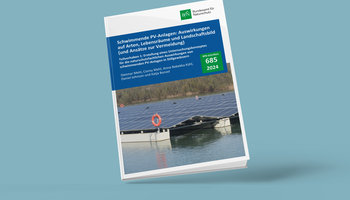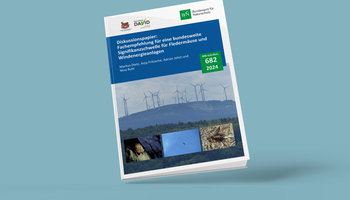Contact
Nature and Biodiversity Conservation Union Rhineland-Palatinate (NABU Rheinland-Pfalz)
Frauenlobstr. 15-19, 55118 Mainz
Cosima Lindemann
Tel.: +49 6131 1403929
Cosima.Lindemann(at)avoid-unrequested-mailsNABU-RLP.de
In order not to exacerbate the "housing shortage" for birds and bats during building refurbishment, environmental and species protection must be linked together and jointly promoted. This three-year project is intended to improve the availability of targeted technical solutions to integrate species protection measures in thermal composite systems.
The project aims to develop technically feasible model solutions ready for series production for integrating species protection measures in modern thermal composite systems. This first requires the integration of technical implementation demands and methodological recommendations for species protection-compatible energy-efficient building refurbishment. Based on this, practical information materials will be developed for energy consultants, architects, town planners, engineers and tradesmen as well as for those involved in environment and species conservation in order to accord the legal aspects of species protection more importance in the guidance, planning and execution of refurbishment measures.
Existing technical solutions and published results on the acceptance behaviour of species living in buildings need to be reviewed and analysed. Next, the collated findings will be assessed in expert workshops in terms of their relevance for practical species conservation. An interim result will be the identification of approaches that are useful from an ecological viewpoint.
These approaches will then be tested for their technical feasibility and for the possibility of certification. An expert assessment report will describe the details of the technical implementation and present these for discussion at an event for experts with stakeholders from the construction and refurbishment sector. The collated findings will be included in the form of model solutions in a handbook on the conservation of species in buildings and thermal insulation. An assessment of the existing certification systems will be made at the same time. At this point in the project, technical discussions should be held with certification providers and manufacturers of external thermal insulation composite systems.
An accompanying project module deals with the identification of approaches to integrate species protection-compliant system solutions in existing funding programmes in order to achieve environmentally compatible refurbishment in the medium-term.
A further analysis of the literature and expert questionnaire needs to be carried out to determine potential conflicts of photovoltaic systems with species living in buildings.
The results of the project will be communicated to a wide audience in various ways. During the project, interim results and information on events will be regularly published on the project website. The planned construction handbook "Gebäudeartenschutz & Wärmedämmung" (conservation of species in buildings & thermal insulation) documents the technical model solutions for the conservation of species in buildings from a practical angle and gives priority to supporting tradesmen and architects with the actual implementation.
Additional information brochures meeting the needs of target groups are aimed directly at nature conservation and trade associations with their varying information needs. A range of (best practice) examples and background information on environment and species protection will be developed for this including the reciprocal requirements of energy law and construction planning and execution on the one hand and species protection law and the the ecology of relevant animal species on the other.
In addition to this, two discussion papers will be compiled: first a discussion paper with further recommendations for action to include species protection measures in appropriate support programmes and, second, a conflict analysis on "photovoltaic and species protection in buildings" that will be summarised in a concluding paper.
The results will be presented in 2021 as part of a two-day closing conference.
Review and identification of existing solutions for a species protection-compatible energy-efficiency building refurbishment: A thorough search of the specialist publications and expert discussions will enable solutions to be collated for species-specific requirements in relation to refurbishment. The findings will be presented for discussion in expert workshops. The focus is on elaborating specific species protection criteria for practical solutions.
Technical checking of feasibility: The module will check the results of Module 1 in terms of technical feasibility in dialogue with relevant institutions and in the framework of an expert assessment. Besides the actual technical feasibility, the expert assessment needs to demonstrate compatibility with existing certifications. After the assessment of various certification systems, these model solutions need to be discussed with potential certification service providers and manufacturers of thermal insulation composite systems as regards their level of willingness to obtain a certification for nest and roosting aids for their products or to develop their own products for series production.
The module should result in sample solutions that meet both the species-specific and structural engineering requirements. A handbook compiled as part of the module will take care of the transfer to the construction and refurbishment practice, supplying the construction engineering details in a professional form in order to support tradesmen and architects in planning and carrying out refurbishments that comply with species protection.
Review of funding programmes: In order to supply the sample solutions for wide application, an assessment and analysis of existing funding programmes from urban development and energy-efficiency building refurbishment will take place at national, regional and possibly local level. This will identify approaches for a reform from the angle of nature and species protection compatibility, and be documented in a discussion paper.
Presenting the conflicts of photovoltaic systems and species protection: As part of the project an investigation will be undertaken on the review of problems and risks of photovoltaic systems related to different types of buildings. The results will be summarised in a discussion paper.
Communication of the project results to different target groups: The presentation of technical solutions including the above-mentioned handbook needs to reach both the construction industry as a whole and the individual energy-efficiency building refurbishment trades. These solutions should also be disseminated through an accompanying public relations exercise and via talks and briefings.
The nature conservation associations, refurbishment networks and industry associations will be addressed via brochures aimed at target groups, a website and accompanying public relations exercise. The main objective is to communicate the facts about "energy-efficiency building refurbishment and species protection" in a universally understandable and solution-focused manner.
Stakeholders in national and regional policy will also be addressed by means of a discussion paper with recommendations for taking account of species protection aspects in funding programmes and accompanying information activities.
Nature and Biodiversity Conservation Union Rhineland-Palatinate (NABU Rheinland-Pfalz)
Frauenlobstr. 15-19, 55118 Mainz
Cosima Lindemann
Tel.: +49 6131 1403929
Cosima.Lindemann(at)NABU-RLP.de
Federal Agency for Nature Conservation (BfN)
FG II 4.1 Landscape planning, spatial and settlement planning
Herr Thomas Arndt
Thomas.Arndt(at)BfN.de
03.04.2024
Weiter

03.04.2024
Weiter

19.03.2024
Weiter
